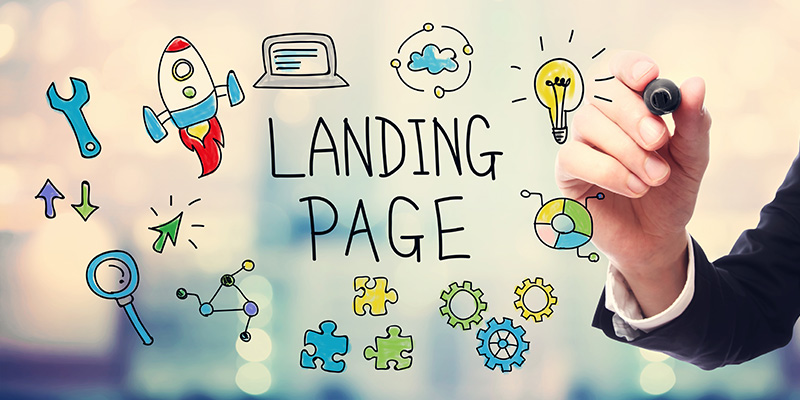Landing pages that convert are integral to the success of your digital marketing campaign. Here, you will learn what makes a good landing page and how to make one.
Construct Landing Pages That Convert Leads Into Customers
What is a landing page? Simply put, a landing page is a standalone web page designed for the sole purpose of converting visitors into buyers. Usually, leads receive links to landing pages through email campaigns, ads, or social media. Landing pages, when done right, can improve your conversion rate, thereby growing your business.
How to Create a Great Landing Page
Designing a landing page can come as a challenge, especially if you don’t know the basics. If you want to learn how to make a good landing page, keep the following tips in mind:
1. Use an Eye-Catching Yet Structured Design
Effective landing pages should be able to convert leads into customers without having to go through a lot of hoops. Therefore, it only makes sense for your landing page layout to be structured and well-organized. Avoid distractions like pop-ups, which will either annoy or divert your reader’s attention. Make sure the flow of the page is natural and easy.
That doesn’t mean you shouldn’t utilize eye-catching layouts, though. A good landing page is both clean and aesthetically pleasing like the one Shopify uses. Color will play a critical role in the success of your landing page, so devote a fair amount of time researching the right color palette that will help you convert.
2. Be Clear and Simple
When learning how to create a good landing page, you must have a clear objective in mind. What do you want your audience to do or take away from your landing page?
Make sure you clearly state all the pertinent information you want your reader to know. Avoid beating around the bush or adding unnecessary details, though. That will only distract your lead from the point. Keep it simple and concise. Use bullet points where appropriate.
It’s also important to know where to place vital information. Key details should be positioned above the fold so that visitors see them immediately. You can always expound on them below the fold.
3. Go for a Captivating Headline
 For most visitors, the headline is the first thing they see. Therefore, it only makes sense to start with a powerful and attention-grabbing headline.
For most visitors, the headline is the first thing they see. Therefore, it only makes sense to start with a powerful and attention-grabbing headline.
If you can pique their interest with your headline, you can get them to stay and read about your offer. Don’t make your headline generic, though.
It should be captivating but also informative such as the one on the TransferWise landing page. It should immediately tell the reader about what value you’re offering. Additionally, keep your headline short. Something below 20 words is good.
4. Write Compelling Subheads
The subhead is where you can expound more on your headline. It’s usually positioned right below the headline, too. Here, you can go into more detail about what it is you’re offering the reader. When writing your subheads, make sure to be persuasive without being pushy. A powerful headline paired with a compelling subhead can convince the visitor to act on your CTA.
5. Use Short and Concise Forms
Forms make it easy for marketers to collect information from visitors. But, if you want to increase your landing page conversion rate, you have to keep your forms short and sweet.
When crafting your forms, only ask for necessary information. The fewer the fields, the better. Nobody wants to spend several minutes inputting their personal details. In fact, limiting your form fields to just four can even improve your conversions by 120 percent. Even the type of information you ask for can affect conversions. You can ask for their name and email address, but age brings down conversion rates.
Lyft is a perfect example of a great landing page with a short form that’s to-the-point. It only asks for a couple of key details before allowing you to move on to the next step in the conversion process.
6. Use Visuals
Humans are inherently visual learners, so it comes as no surprise that we process visual information much faster than text. As such, marketers should use visuals to grab more attention and connect with visitors in a more meaningful way. Go for large, high-quality images that showcase your product or service. Images should always be relevant to your brand.
Many people find it overwhelming to try and digest a huge block of text. In this case, video works as a great substitute. Allow visitors the option of learning about your offer through a clickable video.
7. Tap Into the User’s Psychology
If you want your landing pages to convert, you have to write a good copy that has a psychological edge. Consider writing something that taps into the user’s pain points. People are more likely to respond to an offer if they know they’ve got something to lose. Show statistics, examples, etc. After illustrating this pain point, proceed to offer your product or service as the solution.
Conversely, you can also use pleasure to convert leads into customers. Explain how your product can provide pleasure to the reader. Describe how your product or service isn’t just functional but also emotionally fulfilling.
8. Include Trust Signals and a Guarantee
People are warier of links nowadays, and they often find themselves clicking away if they feel a web page isn’t trustworthy. Therefore, you must make your landing page appear reliable at a single glance.
You can do this by making use of trust signals, which communicates to visitors that your brand and products are credible. Trust signals come in many shapes and forms, including customer testimonials and reviews. You can also provide social proof. Place social media widgets with “Like” counters on your landing page. If you’ve been featured in various media channels and sites, show those as well. Other trust signals include awards, recognitions, and memberships.
Another feature that can earn the trust of your visitors is a guarantee. Choose a guarantee that works with your brand and offer. For instance, if you’re selling a product, you can go with a money-back guarantee. You can even go with something as simple as “No Spam Guarantee.” Make sure to place this guarantee near your call to action to make it immediately visible to the reader.
9. Have A Strong Call to Action (CTA)
How can you let visitors know what the next step in the funnel is? A call to action. Your CTA is what turns leads into buyers. Hence, there are some guidelines you must follow when it comes to creating your CTA.
First of all, with CTA buttons, bigger is better. Of course, that doesn’t mean you should take up the whole screen. Go for something large enough that it captures attention but doesn’t become a nuisance. Your CTA copy should also be powerful. Avoid using generic words like “submit” or “go.” Instead, use persuasive and stimulating words.
As for the button’s color, make sure you go with something that contrasts with your background color. This way, you can really make your CTA button stand out. If you want landing pages that convert, pay close attention to your CTA.
10. Make Specific Landing Pages for Every Target Audience
Marketers rarely stick to one form of promotion or ad. Therefore, you’ll likely receive traffic from various sources. If time and budget permits, it’s a good idea to have a separate landing page for each audience. Have dedicated landing pages for visitors that come from social media, PPC ads, emails, etc.
11. Use the Same Keywords as Your Ads
Consistency is paramount when it comes to marketing your brand, and the same goes for your landing page and ads. The same keywords and phrases in your PPC ads should appear on your landing page as well. This will signal to visitors that they’re in the right place.
You must also make sure that your ads match the landing page you bring them to. For instance, if a lead clicks an ad about a certain pair of shoes, you shouldn’t bring them to a landing page promoting an entirely different product. The shoes are what made them click!
12. Use a Mobile-Friendly Layout
 With about half of all web traffic coming from mobile devices, part of landing page optimization is making sure you don’t get left behind the times.
With about half of all web traffic coming from mobile devices, part of landing page optimization is making sure you don’t get left behind the times.
Make sure your landing pages are mobile-friendly. That means dedicating time to design a layout that works on mobile and is easy to navigate.
You should also make sure all the buttons are clickable and work as intended.
13. Test Your Landing Page
You can’t really know for sure whether your landing page works or not without testing. Test out your landing page’s performance and track results. Don’t forget to test out the CTA button’s placement, color, and copy. You might find that even the slightest change can up your conversion rate.
What Makes a Great Landing Page
Many businesses have a hard time marketing their products and services because they don’t know how to design an effective landing page. By following these tips, though, you, too, can construct landing pages that convert leads into buyers. You might not get it right on the first try. But, over time and through testing, you’ll eventually get there.
Tanner Grey specializes in digital marketing and web page design. If you want help crafting great landing pages, give us a call today at 844.500.1339 or contact us online.
RELATED ARTICLES:
- Images In Marketing: Doing Them Right
- A Quickstart Guide On How To Optimize ECommerce Websites
- How to Have Effective Website Capture Forms







